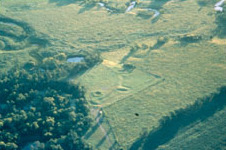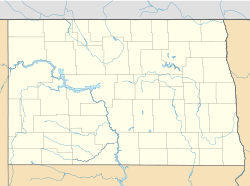Menoken Indian Village Site facts for kids
|
Menoken Indian Village Site
|
|

Aerial view of the site
|
|
| Nearest city | Bismarck, North Dakota |
|---|---|
| NRHP reference No. | 66000599 |
Quick facts for kids Significant dates |
|
| Added to NRHP | October 15, 1966 |
| Designated NHL | July 19, 1964 |
The Menoken Indian Village Site is an important old village site near Bismarck, North Dakota. It's also known as the Menoken Site, Verendrye Site, or Apple Creek Site.
This site was a fortified village. People lived here around the year 1300. It's very important for understanding the history of the area. This is because it's one of the few sites that existed before the well-known Hidatsa, Mandan, and Arikara cultures.
The Menoken Indian Village Site was named a National Historic Landmark in 1964. This means it's a very special place in American history. You can find it on 171st Street NE, north of Menoken. It's about 16 kilometers (10 miles) east of Bismarck. The state of North Dakota manages the site as the Menoken Indian Village State Historic Site, and it's open for everyone to visit.
Contents
What Does the Site Look Like?
The Menoken Site sits on a flat area next to Apple Creek. This creek flows into the Missouri River near Bismarck. The village was protected by a large earthwork. This was like a defensive wall made of earth.
The Defensive Ditch
The main part of this defense is a ditch. It is about 245 meters (800 feet) long. This ditch has four rounded sections that stick out. These sections are called bastions. They were probably used to help defend the village.
The ditch is about 1.5 meters (5 feet) deep. It is also about 6 to 7 meters (20 to 23 feet) wide. The ditch forms a curve, covering about 100 degrees of a circle. It protects an inner area of about 0.6 hectares (1.5 acres).
Inside the Village
Archaeologists have found signs that there was once a palisade just inside the ditch. A palisade is a fence made of strong wooden posts. Only the holes where these posts once stood remain today.
Inside the protected area, there were likely 11 to 13 homes. These homes were semi-underground structures. This means they were partly dug into the ground.
Discovering the Past
People first started digging at this site in the 1930s. For many years, experts thought it was a Mandan village. They believed it was the village visited by a French explorer named La Verendrye.
New Discoveries
However, new archaeological digs in the 1990s and early 2000s changed this idea. These studies showed that the site is actually older than first thought. It was probably used between the years 1100 and 1300. This means it was likely home to the ancestors of the major Native American groups in the region.
The village was probably a place where people lived for part of the year. From here, they would hunt bison and other animals.
What Was Found?
Many interesting things have been found at the site.
- Stone tools: Most of these tools were made from stone found near the Lynch Quarry Site to the west.
- Pottery pieces: Fragments of ceramic pots have been discovered.
- Bone tools: Tools made from animal bones were also found.
A Special Historic Site
The Menoken Site was named a National Historic Landmark in 1964. This was mainly because people thought it was linked to La Verendrye. Even though that idea changed, the site is still very important. It helps us understand the timeline of prehistoric life in the region. Its archaeological importance is huge.
The state of North Dakota bought the site in 1937. Today, it is open to the public. There is a walking trail with signs that explain the history of the site.



